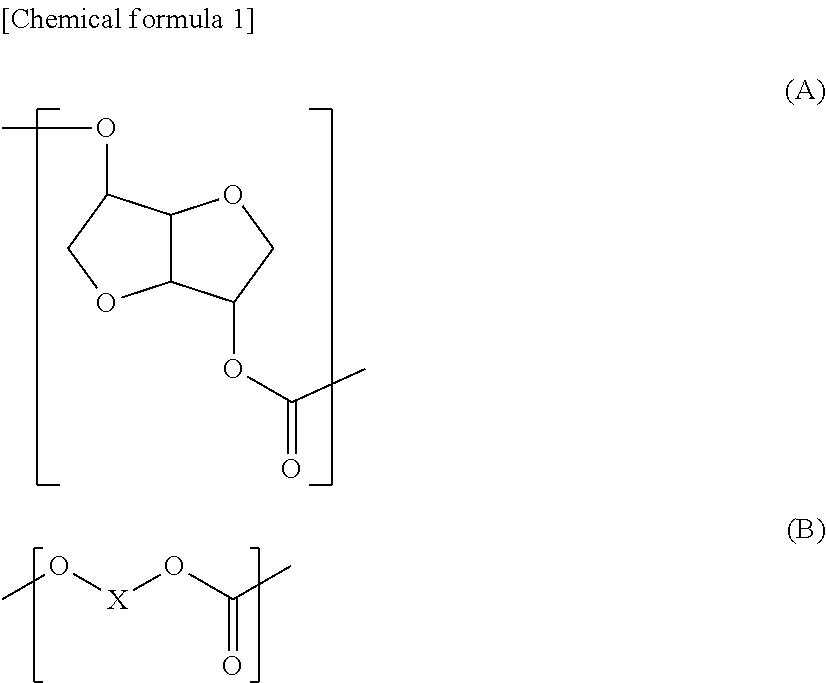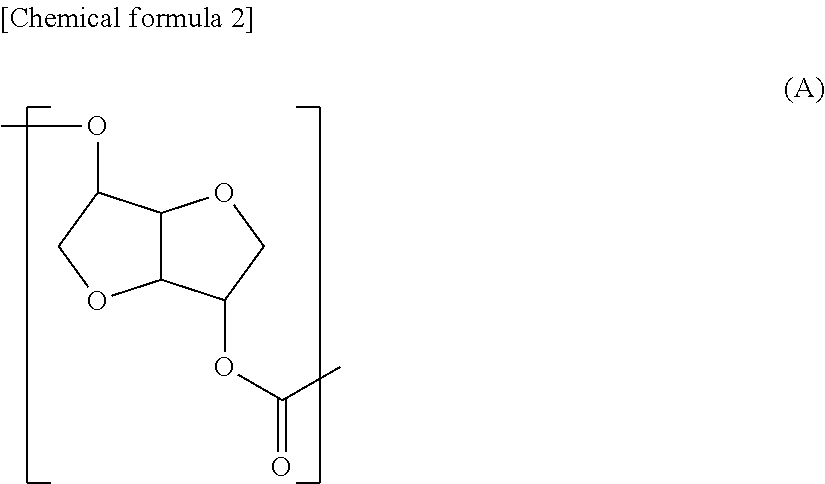Polycarbonate diol and producing method thereof, and polyurethane and active energy ray-curable polymer composition both formed using same
a technology which is applied in the field of polycarbonate diol and production method thereof, and the formation of polyurethane and active energy raycurable polymer composition both using same, to achieve the effects of excellent hardness and friction resistance, excellent contamination resistance, and high hardness
- Summary
- Abstract
- Description
- Claims
- Application Information
AI Technical Summary
Benefits of technology
Problems solved by technology
Method used
Image
Examples
experimental example 1-1
[0370]1,6-hexanediol: 195.9 g, isosorbide: 242.3 g, diphenyl carbonate: 658.2 g, and magnesium acetate tetrahydrate: 4.3 mg were put into a 1 L glass separable flask, which was equipped with an agitator, a distillation trap, and a pressure adjusting device, and nitrogen gas replacement was conducted. The content was heated to 160° C. at its internal temperature for dissolution and for one-hour reaction. Then, the pressure was reduced down to 0.27 kPa gradually in two hours to distill and remove phenol and unreacted diol during the reaction. Then, nitrogen gas bubbling was conducted at 180° C. and 2.7 kPa for 45 minutes to distill and remove phenol and unreacted diol during the reaction. 400 g of o-dichrolobenzene was added and the pressure was maintained at 0.27 kPa and 130° C. for 2 hours for reaction, then bubbling with nitrogen gas was conducted for 2 hours at 2.7 kPa to remove the phenol and raise its polymerization degree of polycarbonate diol. The obtained polycarbonate diol p...
experimental example 2-1
[0373]1,6-hexanediol: 293.9 g, isosorbide: 121.2 g, diphenyl carbonate: 658.2 g, and magnesium acetate tetrahydrate: 4.3 mg into a 1 L glass separable flask, which was equipped with an agitator, a distillation trap, and a pressure adjusting device, and nitrogen gas replacement was conducted. The content was heated to 160° C. at its internal temperature for dissolution and for one-hour reaction. Then, the pressure was reduced down to 0.27 kPa gradually in two hours to distill and remove phenol and unreacted diol during the reaction. Then, nitrogen gas bubbling was conducted at 180° C. and 2.7 kPa for 15 minutes to distill and remove phenol and unreacted diol during the reaction. 400 g of o-dichrolobenzene was added and the pressure was maintained at 0.27 kPa and 130° C. for 5 hours for reaction, then bubbling with nitrogen gas was conducted for 13 hours at 2.7 kPa to remove the phenol and raise its polymerization degree of polycarbonate diol. The obtained polycarbonate diol product w...
experimental example 3-1
[0376]1,6-hexanediol: 218.5 g, isosorbide: 264.4 g, a diphenyl carbonate: 620.0 g, and magnesium acetate tetrahydrate: 4.7 mg were put into a 1 L glass separable flask, which was equipped with an agitator, a distillation trap, and a pressure adjusting device, and nitrogen gas replacement was conducted. The content was heated to 160° C. at its internal temperature for dissolution and for one-hour reaction. Then, the pressure was reduced down to 0.27 kPa gradually in two hours to distill and remove phenol and unreacted diol during the reaction. Then bubbling with nitrogen gas was conducted for 1.5 hours at 160° C. and 0.27 kPa to remove the phenol and unreacted diol. Then bubbling was conducted for 4 hours at 110° C. with the pressure kept at 0.27 kPa to remove the phenol. The obtained polycarbonate diol product was 520.5 g.
[0377]The number average molecular weight (Mn) obtained from the hydroxyl value of the polycarbonate diol contained in this polycarbonate diol product was 880, (A)...
PUM
| Property | Measurement | Unit |
|---|---|---|
| temperature | aaaaa | aaaaa |
| molecular weight distribution | aaaaa | aaaaa |
| tensile elongation at break | aaaaa | aaaaa |
Abstract
Description
Claims
Application Information
 Login to View More
Login to View More - R&D
- Intellectual Property
- Life Sciences
- Materials
- Tech Scout
- Unparalleled Data Quality
- Higher Quality Content
- 60% Fewer Hallucinations
Browse by: Latest US Patents, China's latest patents, Technical Efficacy Thesaurus, Application Domain, Technology Topic, Popular Technical Reports.
© 2025 PatSnap. All rights reserved.Legal|Privacy policy|Modern Slavery Act Transparency Statement|Sitemap|About US| Contact US: help@patsnap.com



